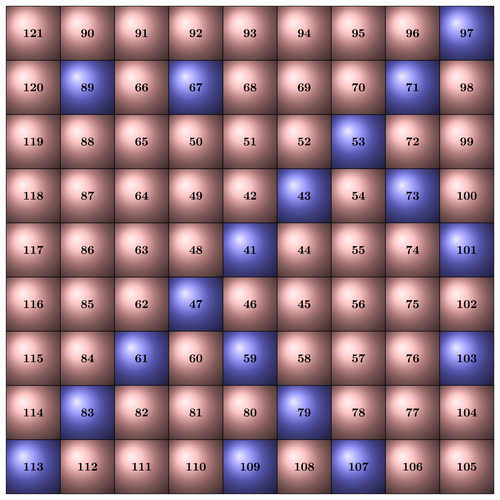The Ulam spiral reveals some interesting prime number patters. The code is an excellent example of how TeX' control logic can be used to create complex drawings. Experiment with the code to reveal other prime number patterns.

Edit and compile if you like:
% Ulam spiral
% Author: Alain Matthes (http://altermundus.fr/)
\documentclass[]{article}
\usepackage{ifthen,fullpage}
\usepackage{tikz}
\newcounter{cmpt}
\newcounter{next}
\newcounter{end}
\makeatletter
\newcounter{prim@a}
\newcounter{prim@n}
\newcounter{prim@d}
\newcounter{prim@b}
\newboolean{reponse}
\newcommand*\primality[1]
{\setboolean{reponse}{true}
\setcounter{prim@n}{#1}
\ifthenelse{\value{prim@n}=0}% n = 0
{\setboolean{reponse}{false}}
{\ifthenelse{\value{prim@n}=1}% n =1
{\setboolean{reponse}{false}}%
{\ifthenelse{\value{prim@n}=2}{}% n = 2
{\ifthenelse{\value{prim@n}=3}{}% n = 3
{\ifthenelse{\isodd{\value{prim@n}}}% n > 3 parité ?
{\setcounter{prim@a}{#1}
\setcounter{prim@d}{3} % n impair on continue
\whiledo{\value{prim@a}>\value{prim@d}}% deb whiledo
{\setcounter{prim@a}{\value{prim@n}/\value{prim@d}}
\setcounter{prim@b}{\value{prim@a}*\value{prim@d}}
\ifthenelse{\value{prim@b}=\value{prim@n}}%
{\setboolean{reponse}{false}
\setcounter{prim@d}{\value{prim@a}}}%
{\addtocounter{prim@d}{2}%
}%
}% end whiledo
}
{\setboolean{reponse}{false}}% n est pair
}%
}%
}%
}
}%end macro
\makeatother
\newcommand*\ballcolor{%
\stepcounter{cmpt}
\primality{\value{cmpt}}
\ifthenelse{\boolean{reponse}}%
{ \colorlet{colornb}{blue!50}}%
{ \colorlet{colornb}{red!30}}%
}
\newcommand*{\ulam}[2]{%
\setcounter{cmpt}{#1}
\addtocounter{cmpt}{-1}
\setcounter{next}{0}
\setcounter{end}{#2}
\ballcolor
\node(place) at (0,0) {$\mathbf\thecmpt$};
\whiledo{\value{cmpt}<\value{end}}%
{
\foreach \i in {0,...,\thenext}
{\ballcolor
\node[above of=place] (place) {$\mathbf\thecmpt$};
}
\foreach \i in {0,...,\thenext}
{
\ballcolor
\node[right of=place] (place) {$\mathbf\thecmpt$};
}
\stepcounter{next}
\foreach \i in {0,...,\thenext}
{
\ballcolor
\node[below of=place] (place) {$\mathbf\thecmpt$};
}
\foreach \i in {0,...,\thenext}
{
\ballcolor
\node[left of=place] (place) {$\mathbf\thecmpt$};
}
\stepcounter{next}
}
\addtocounter{next}{-1}
\foreach \i in {0,...,\thenext}
{
\ballcolor
\node[above of=place] (place) {$\mathbf\thecmpt$};}
}
\begin{document}
\begin{center}
\begin{tikzpicture}
\tikzstyle{every node}=[draw,%
rectangle,%
shade,%
minimum size = 1.6cm,%
ball color = colornb,%
node distance = 1.6cm]
\ulam{41}{113}
\end{tikzpicture}
\end{center}
\end{document}Click to download: ulam-spiral.tex • ulam-spiral.pdf
Open in Overleaf: ulam-spiral.tex


